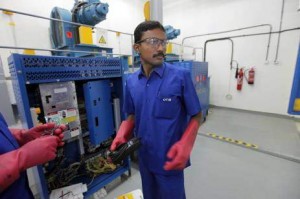By Carol Huang www.thenational.ae
DUBAI // Vishwas D’Mello has worked the graveyard shift for five years, crouching in hidden shafts to fix machines that people use nearly every day but almost never think about.

Lifts made Dubai’s skyline possible, and they work thanks to a nocturnal army of mechanics maintaining ever more complex systems – all to deliver passengers from floor A to floor B within seconds.
“The best compliments people can have is they don’t notice them or complain about them,” said Jim Fortune, a consultant who helped design Dubai’s most popular lift, a 124-storey system that takes visitors to the observation deck of the Burj Khalifa.
Around midnight every night hundreds of lift technicians like Mr D’Mello fan out across Dubai, pushing buttons and checking motors to make sure the machines can handle another month of ups and downs.
They dust off weeks’ worth of footprints. They mount the top of lifts to grease the shafts. They crouch in the bottom of shaft to clear litter. They test the speakers, the doors, the sensors.
Maintaining one lift can take up to four hours, said one technician, Shavanas, who did not want to give his last name. To do his work, he gets three uniforms and a new pair of sturdy shoes each year. He also receives free laundry service. He carries a toolbox full of wrenches and screwdrivers and a digital meter. He earns Dh2,500 a month.
The 24-year-old Indian and his partner mechanic, Mohideem Haleem, 27, who is also from India, received several weeks of training before getting their own maintenance route. Between them they have 10 years’ experience inspecting and repairing lifts.
Technicians such as Shavanas and Mr Haleem must possess specialised knowledge, and should ideally receive regular training, as lifts grow more and more complex as technology advances. Many systems include sensors to log minute-to-minute details, which the pair analyse to guide their work. Some systems feed the data to call centres that monitor lifts constantly, checking for problems.
Using artificial intelligence, lift systems whisk through formulas to figure out whom to pick up where. Some can detect “malice” – that is, eager children who push 10 buttons at a time just for fun. They use infrared sensors to detect if anyone steps across the lift’s threshold – if no one enters for two storeys, they skip the remaining eight.
The goal of all this technology is to cut the time that passengers wait before they begin to grumble – which usually happens in less than a minute.
In an apartment building, the industry aims to pick up riders within 35 seconds. In a hotel it shoots for 30 seconds, and in an office building it allows only 20.
By that metric, Mr Fortune said, Dubai, despite boasting so many skyscrapers, is actually “under-elevatored”. It has on average too few lifts per building.
Some developers, in their hurry to erect towers during the real estate boom, rushed their analysis of how many lifts they needed. Others converted residential buildings halfway through construction into commercial ones, which are host to more people, at least during working hours.
Then, as the building frenzy waned, developers began to skimp on cost.
“In the end, people didn’t want to pay for anything,” said Mr Fortune. “Elevators are like computers. You pay for capacity and speed.”
Of course, some lifts are simply built to run faster. The Burj Khalifa’s broke the world record as the fastest double-decker system; it zooms up at a speed of 10 metres per second.
Crowds queue for hours for a trip that lasts two minutes.
The Burj Khalifa lift also drew worldwide attention, however, when it suddenly stopped between floors. Anxious passengers sat inside the windowless box in a dark tunnel for nearly an hour. And only 30 days after the building officially opened, the lift shut down for two months.
That’s the sort of trouble – and negative publicity – that unseen technicians like Mr D’Mello and Mr Haleem and Shavanas are hired to prevent.
“Trouble calls cost a lot of money,” said Mr Fortune. “The key is preventive maintenance.”














